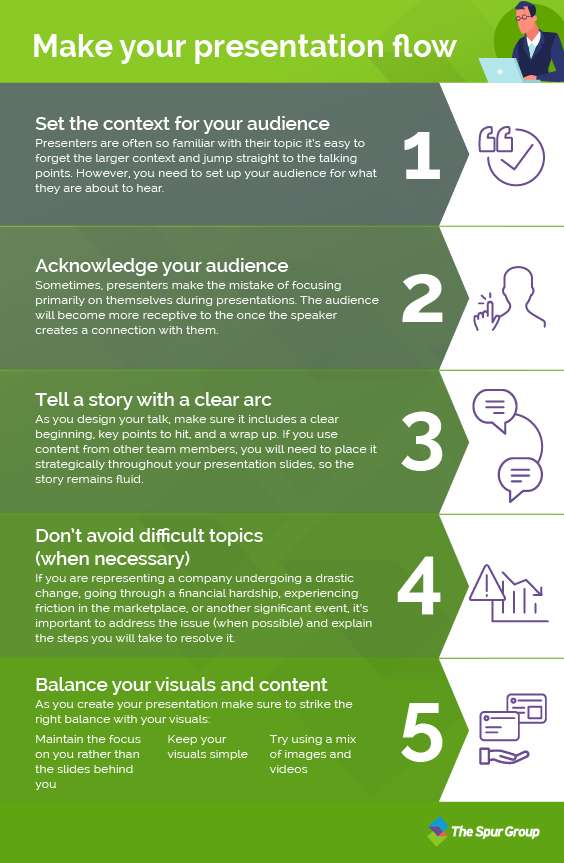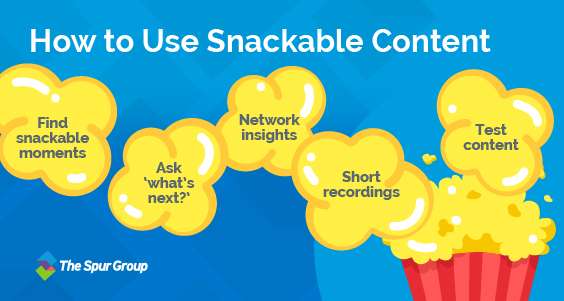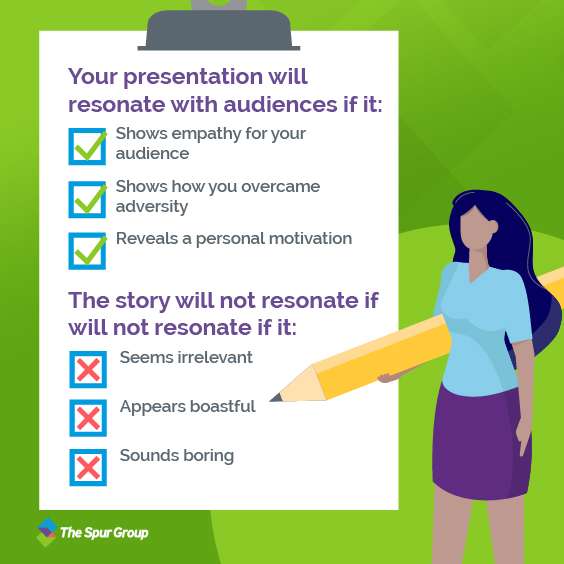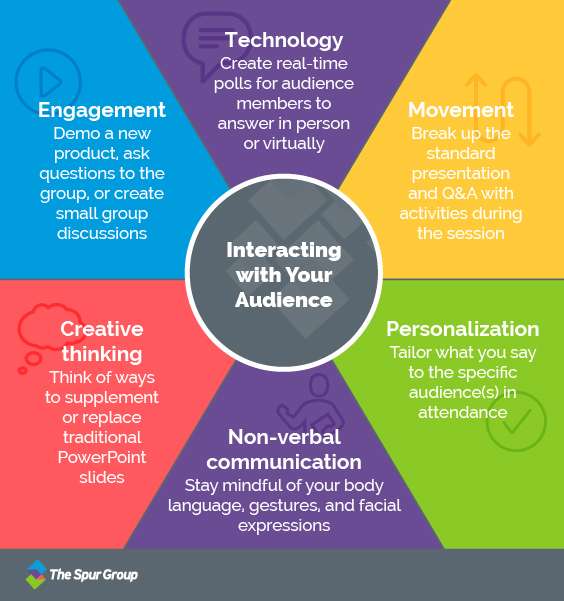Within an infinite number of corporate events out there, how can you make sure yours stands out? Better yet, when your event is over, how do you ensure your attendees will feel like they gained value from what you had to offer?
A meaningful presentation will help you build strong professional relationships, build your credibility, and maintain your presence as a leader. To create a valuable corporate event, you must consider a variety of factors. However, one of the most important elements to consider is the presentations and content. A strong corporate presentation will include meaningful, easily consumable content connected to your event goals, tell a story, use clear language, and prioritize audience interaction.
Our years of experience helping industry leaders conceptualize and manage successful events has allowed us to create our own proven, concrete approach to corporate event planning. We’re sharing our tips with you in a two-part blog series.
In our first post, we covered how to choose your event type, create an agenda and goals, determine your overall message, and keep your attendees happy.
In this second and final post in the series, we will dig deeper and focus on how to create an impactful corporate presentation.
Be intentional with your content
What Bill Gates said in 1996 still rings true today. When it comes to building influence, content is king. Further, content plays a significant role in meeting your audience’s needs and communicating your message.
Just as the most successful conferences and meetings incorporate the themes in all aspects of the event, using the right content can add needed depth to the talk. Taking a cue from your event’s strategy and goals, consider the types of content that will tie the main takeaways together for your audience. What is the message that you want the audience to carry home at the end of the event, or your call to action at the closing keynote?
Establish your presentation’s outcome and goals
Hosting corporate events and conferences offers a unique opportunity to share insights, discuss strategy, and connect with industry leaders. However, fully connecting with your audience requires a clear understanding of their needs and your goals for the event.
One way to frame your thinking about connecting with your audience is using the “know-feel-do” framework. This exercise will help you outline your presentation’s main ideas as you identify the most relevant topics to your audience, as well as the takeaways for attendees.
Breaking it down, here are the three key focus areas:
Know
What information do you want your audience to take away from your presentation?
As an example, the answer could include your company or team’s plans for success, details on a new initiative, how to solve a common industry challenge or details on a new program. The key is to determine the main points that you want people to absorb throughout the presentation.
Feel
What emotional response do you want to elicit from your audience?
For example, do you want attendees to fear the status quo, get excited about your new approach, or gain confidence in your leadership team?
Knowing how you want attendees to feel will help you test word choice as you create your presentation’s messaging. We will offer more insight on how to evoke emotion from your audience later in this post.
Do
How will you turn your audience’s attention and interest into action?
As you ponder the answer, follow two pieces of advice:- First, limit yourself to identifying three to five key actions per presentation. The odds are low that someone would follow through on more than a handful of steps.
- Second, be specific. Whether you want your audience members to reach out to an account manager or review the revenue opportunities of your latest offering, using direct instructions will give attendees clarity on next steps.
Building a clear understanding of what you want your audience to know, feel, and do will add exponential value to your content.
Make your presentation flow
At any one time, today’s professionals are often juggling several tasks demanding their attention, often on multiple devices, which is why during your presentation, it’s important to captivate your audience quickly and find a way to hold their attention. At The Spur Group, we’ve worked with numerous executives to build and deliver presentations that resonate with people. We offer five tips that you can use to ensure your next presentation flows well:
Set the context for your audience
Inevitably, you have a lot of information to cover throughout your presentation. Your topics may include new solutions that are faster and less expensive than your competition, additional services that make it easier for your customers and partners to implement solutions or innovative financing options that make the buying decision easier for your customers.
Presenters are often so familiar with their topic that it’s easy to forget the larger context and jump straight to the talking points. However, you need to set up your audience for what they are about to hear. Otherwise, they won’t understand the significance of your main talking points. Once the audience understands the full narrative, the likelihood increases that they’ll be receptive to your key points.
Acknowledge your audience
Sometimes, presenters make the mistake of focusing primarily on themselves during presentations. You might be familiar with this type of speech:
“We are so pleased to be here. As a leader in software and technology solutions, we have a lot of new innovations we are excited to tell you about, but these are just another step in our long history of ground-breaking work. Over the past 10 years, we have deployed more than our share of firsts...”
Why should your audience care about your company? How does it affect them?
Consider this alternative:
“We are so pleased to be here today, talking with some of our most important customers. As a company, we have several jobs. One of them is to listen to you with great intensity. Custom feedback has informed all of our most important innovations, and today, we’re excited to share some new ones with you...”
In this example, the speaker positioned customer feedback as a primary reason for the speaker’s success. The audience will become more receptive to the presented information once the speaker creates a connection with them.
Tell a story with a clear arc
Say you’ve been asked to speak about your organization’s approach to change management at an international conference. You may consider asking each of your team leaders to submit a section for the presentation. However, content from many different authors and perspectives can hinder the flow of your story.
You don’t have to do everything yourself. But you do need to build your presentation with a clear story arc in mind. As you design your talk, make sure it includes a clear beginning, key points to hit, and a wrap-up. If you use content from other team members, you will need to place it strategically throughout your presentation slides, so the story remains fluid. In other words, the content you gather from your team should be restructured to follow the arc you’ve developed.
Don’t avoid difficult topics (when necessary)
It’s common to want to focus on the positives when preparing for a presentation, however, this isn’t always the right approach when there’s an elephant in the room. Usually, if you are dancing around the obvious topic, the audience will notice.
If you are representing a company undergoing a drastic change, going through a financial hardship, experiencing friction in the marketplace, or another significant event, it’s important to address the issue (when possible) and explain the steps you will take to resolve it. Being transparent about the conflict at hand will allow you to build credibility with your audience. At first, your words may evoke feelings of anger, disagreement, disgust, and surprise within your audience. However, choosing to address a tough discussion can create a powerful opportunity to inspire your audience.
Balance your visuals and content
You’ve likely sat through presentations displaying charts and graphs with indecipherable numbers or images that do not add value to the speaker’s key points. Nevertheless, there are endless ways to make a presentation visually appealing.
Renowned author and motivational speaker Simon Sinek rarely uses any sort of presentation deck. He is known for his ability to deliver captivating presentations with nothing more than a large pad of paper and a marker.
Emulating Simon’s simplistic yet powerful delivery style, here are three suggestions to remember when creating your presentation’s visuals:
- Maintain the focus on you rather than the visuals behind you
- Keep your visuals simple
- Try using a mix of images and videos
Try to balance the visuals and words on your slides. Often, you’ll see executive presentations with visual slides that have one or two words. According to experiments in communication and memory, information delivered through images is more memorable than information delivered through words alone.
The measure of an impactful presentation is whether you’re able to leave a lasting impression on your audience. Delivering a powerful message is the key to inspiring everyone to act. By cultivating a powerful connection with attendees, setting the context, telling a story, addressing tough topics, and using meaningful visuals, your audience will walk away from your demonstration feeling motivated and empowered.

Use snackable content
One way to help you balance your visuals and words in your presentation is to find opportunities to use snackable content. Snackable content is shorter, easily consumable content that’s often a concise version of more complex information. Our experts at The Spur Group offer five ways to use it in your next event:
Find your ‘snackable moment’
Look for places where you can break down big ideas into small parts. Try to break down those ideas as briefly as you can. Look for concepts that can be conveyed effectively in no more than 10 minutes. Five minutes or less is even better.
Within your broken-down ideas, try to find your snackable moment. In other words, your objective is to identify opportunities for a speaker to succinctly provide insight on a single problem or pain point and concisely present your business solution. Then develop the talking points. Spare the details unless they add meaning and value to your main points. Remember, you just want to convey one or two critical ideas.

Leave the audience with a teaser
By the end of your speech, your audience may be thinking, ‘What’s next?’
Take advantage of that emotion and end each presentation with a leading question. For example, “That solved our first problem. But what happens in this (next) scenario?” or “You might think that’s the hardest part. Have you thought about (next issue)?”
You want to entice the audience to attend the next session or watch the next video in the series.
For example, “That solved our first problem. But what happens in this (next) scenario?” or “You might think that’s the hardest part. Have you thought about (next issue)?”
Use insights from your own network
Anyone can be an expert on a certain topic for just five minutes! Identify people in your own network who have specialized expertise and perspectives on topics relevant to your presentation’s main ideas.
Some ideas of people other than yourself that you could gather content from could include those who:
- Speak with customers after their first inquiries
- Follow up after a purchase
- Talk to your vendors
- Answer emails or reply to tweets and comments on social media when problems arise
- Deal with gathering feedback after events
- Write your annual report or present to your board of directors
- Have been with the company the longest
- Are the newest hires
- Are always the first person to brainstorm new ideas and embrace new tech
- Sit on your board of directors
All of these people have unique points of view and knowledge that can be converted into snackable content.
Film and repurpose
Whether your event is virtual or in person, be sure to record all the short presentations.
You can showcase your videos on your company website and social media accounts. Once your event is over, your customers won’t want the material to be gated. Provide links and remind them of your hashtags. Do your best to show people the relevance of each video and how one piece of content links to another. Guide them through your event tracks or themes and highlight the kinds of questions you’ve answered or problems your business has solved.
You could even take it a step further by following up with your CRM and targeting or re-targeting people who would appreciate the fast, easily understood responses to common concerns.
Test your content
Let data drive your decisions. If your developers, salespeople, CEO, or stakeholders need to be convinced of the value of snackable content for your event, test short posts and videos versus longer ones before your event. Identify which get more engagement. Gathering data on the most effective content beforehand will give customers a voice to tell you what kind of content they really want.
Snackable content is a simple, effective way to grab customer attention and leave an impact on them. And just like the best snacks, customers will keep wanting more!
Use real language
How can you ensure your message to your audience is clear? No matter how dynamic your content or the quality of your presentation skills are, if you use wordy language or jargon, your message will get buried. Using precise and accurate language will ensure the clarity and quality of your presentation.
Here are three ways to help clean up your language:
Say what you mean
This may seem like an obvious guideline, but using flowery, inaccurate language is a common mistake. Without realizing it, sometimes presenters will use language that is approximate, but not exact to the message they intend to convey. For example, take the words “viable” and “feasible.” They are often used interchangeably — but they do not mean the same thing. “Viable” refers to whether or not something is capable of surviving, whereas “feasible” refers to whether something is possible. Choose words that most accurately portray what you mean.
Avoid jargon
No one would ever speak German to a Spanish-speaking audience. In the same sense, you shouldn’t use highly technical words or phrases with an audience who is unfamiliar. Communicate in a clear, common language, using layman’s terms when necessary. Avoid jargon and acronyms unless you know everyone in the audience will know what you mean. For example, financial analysts will have a different level of technical understanding than a group of chief information officers. Adjust your language to accommodate your audience.
Use short sentences
Less is more. Remain mindful of the fact that your audience has a short attention span. Use precise words and brief sentences. Stick to your main points by only adding sentences that will add value to your presentation. Often, using several short, pithy sentences will have a greater impact than using one compound sentence.
Use the power of storytelling
Nothing could be more revealing about someone than a powerful personal story. If you plan to share a personal story, you must commit to being vulnerable with your audience. If you pick the right story to share, your listeners will walk away from your presentation feeling empowered or inspired. The right tale will not only encourage your audience to listen, but to live, act, and ultimately become ambassadors for your message.
The story you plan to share will resonate with your audience if you can answer yes to the following questions:
1. Does the story show empathy for your audience?
Your audience wants to feel heard and understood. For example, an executive leader may share the following: “Ten years ago, I was sitting exactly where you are now. I was listening to other executives and wondering how I could make my team successful.” The story is simple, yet effective because the speaker is putting themselves in the shoes of the spectators.
2. Does the story show how you overcame diversity?
When you are willing to tell others how you’ve failed, you are allowing yourself to connect with and inspire your audience. No matter how challenging the obstacle you once faced was, attendees will appreciate you acknowledging the fact that you’re human too.
3. Does the story reveal a personal motivation?
Everyone is motivated by different drivers. For some, it could be family. For others, it could be success in their industry. Tell a story that reveals what motivates you. Your audience will feel they can relate to you on a personal level, which will build your credibility.
On the other hand, your story will not resonate with your audience if it’s:
1. Irrelevant
If your story is unrelated to your presentation’s main message, attendees will likely start to wonder why you’re talking about yourself. An irrelevant story will cause you to lose credibility with your audience and you will look unfocused and off-topic.
2. Boastful
There is a discernible line between expressing empathy and boasting. Sometimes, presenters will fall into the trap of regurgitating their full resumes with the achievements highlighted. Telling a story with the intention of boosting your self-image will separate you from the audience and make you seem less authentic.
3. Boring
If your story isn’t interesting and lacks a conclusion, your audience will likely drift away and start distracting themselves by getting on their phones. Make sure your story has a clear beginning, middle, and end. You can get a sense of how your attendees will respond to the story by telling it to your friends or co-workers beforehand.

Real-life example: Seattle coffee company inspires company pride through stories
Every company event can be inspiring with the right story. For example, a Seattle coffee company held an event for its store managers. Executive leaders wanted to find a way to inspire the management team and increase their sense of pride in the company. The executives determined that “company pride” would be the event’s main message. To demonstrate company pride, company leaders decided to tap into the company’s history, its core value of compassion, and the quality of its product — a three-pronged approach to the core message.
First, the company’s executive team created an interactive experience that reinforced cohesion and pride. Attendees were encouraged to create post-it notes that shared their definition of leadership when they arrived. The exercise was a great way to spark conversations amongst attendees.
Second, not only did the event have coffee tastings, but it also showcased the growers’ stories so managers could learn about the farms where their beans were grown. The information was interesting information for coffee professionals and created a stronger bond between the managers and coffee suppliers.
Further, attendees had the opportunity to demonstrate compassion, the company’s core value, through a community restoration project. Hands-on work fostered connections among the different store managers. By the end of the event, the store managers felt inspired to perform their jobs better, share their stories with customers, and represent their company. The event was a success on all counts.
Stories are a universal way to connect with others. When used the right way, they are the key to effectively influencing your audience. A powerful story will instantly elevate your event to a moving and memorable moment for the audience.
Interact with the audience
No matter whether it’s in person or virtual, everyone goes to an event hoping to learn something new.
When a panel gets repetitive, or your keynote speaker’s speech doesn’t resonate with the audience, it’s only natural that your attendees will lose interest. How do you make sure your presentation is so intriguing that your attendees won’t be tempted to pull out their phones or laptops?
We offer six best practices to hold your audience’s attention:
1. Use technology for interaction
Take advantage of the fact that most people are glued to their electronics. Create polls for attendees to respond using their phones or computers, which will help your audience will stay involved and attentive while you receive real-time data. You could also create polls on social media for people who aren’t able to attend your event in person, so they can still participate virtually. If your event is virtual, you can poll people and ask questions in the meeting chat.2. Engage with your audience
Create a new, engaging, and fun experience for your attendees. You can interact with the audience, even if it’s as simple as asking for a show of hands or moving through the crowd. If your event is virtual, you can engage by asking people to respond in the meeting chat or thumbs up/down on video.
Another idea that’s perfect for smaller events is creating small groups (ideally based on interest areas) for discussion and then bringing everyone back together to discuss the takeaways. You can also use this method if your event is virtual through the breakout room feature. Finally, you can keep your attendees interested by showing and demonstrating a new or unreleased technology or product. If your event is in person, allow the audience to see the product up close and interact with it.
3. Keep your audience moving
Sitting all day long is boring and uncomfortable. Break up lectures with small bursts of movement. Rather than speaking for an hour and then going straight into a question-and-answer session, divide your lecture in half. Incorporate activities in the break that introduce movement and reinforce the information shared in the speech. Then, assign one final exercise before the question-and-answer section. If your event is virtual, you could schedule multiple breaks for attendees to take a quick walk or get some fresh air. Ultimately, your material and content will resonate on a deeper level with the audience if they have more time to engage with the speaker’s ideas.
4. Personalize to your audience
This may seem obvious, but always read the room, even if you are in a virtual setting. Depending on the number of attendees, you can determine how personal you will make your speech. Think about the typical event your attendees attend and make sure your content, activities and presentation language are tailored to their needs and perspectives.
5. Remain mindful of your non-verbal communication
Stay mindful of your body language, gestures, and facial expression. If you aren’t a natural speaker, it could be helpful to watch videos of powerful speakers, then copy their body language or style of engaging the audience. Non-verbal behaviors engage the audience as much as, if not more than, the content of your speech. If you look stiff and uncomfortable, your listeners will start to disengage.
6. Creative thinking
Adapt your presentation to include unique ways to showcase your main ideas and content. Try to find ways to make your main points without relying completely on PowerPoint slides, which can grow repetitive after a while. Incorporate videos or demonstrations to break up the time. Remember, showing how something works in a visual or interactive way leaves a stronger impression than simply explaining how it works.

Keep your audience engaged in any event setting
If you are presenting at a virtual event hosted by your company, you can take some cues from data platform Splunk on how to keep your audience’s attention. To make its digital events stand out, Splunk uses a dynamic and interactive interface that guides attendees through different digital ‘rooms.’ The rooms include waiting areas for sessions (such as an entry plaza at a theater), networking lounges, partner ‘zones’ to showcase Splunk’s partners, a theater for live sessions, and a game room.
Additionally, Splunk provides a sponsor expo hall for attendees to browse content and chat with each other, either one-on-one or in groups. To encourage participation during sessions, Splunk will sometimes host scavenger hunts for members of its virtual audience who can earn prizes for completing activities.
Real-life examples of engagement
Google's annual developer event
At Google’s annual I/O event in 2019, the company offered endless ways to keep its audience engaged. The conference typically brings together developers from around the globe to network, get a first look at the latest Google products, and engage in hands-on learning with Google experts.
The three-day outside tech ‘festival’ featured endless interactive learning sessions, including sandboxes, code labs, app reviews, office hours, and meetups for networking before, during, and after the event. The sandbox stations provided attendees with hands-on demos of Google’s newest technology. One sandbox showcased augmented reality (AR) use cases by bringing an espresso machine ‘to life’ through augmented images. If attendees scanned the code associated with the espresso machine on their smartphones, a lifelike version of the espresso machine appeared on their screens and allowed them to explore the different features and capabilities in an interactive way. By using AR technology in real-time, attendees could better grasp and visualize the benefits of using Google’s AR technology to showcase their own business’ products.
Dreamforce
How do you keep your audience engaged if your event setting falls somewhere in between in-person and virtual? Salesforce’s 2021 Dreamforce event set a new standard for all hybrid events moving forward. More than 1,000 people were invited to attend the event in person, and attendees from 177 different countries joined virtually from home.
Guests who attended in person saw live musical performances, celebrity appearances, and could participate in live educational programming sessions. Virtual attendees could watch performances and participate in learning sessions either in real-time or on-demand through Salesforce’s online streaming platform, which featured more than 125 hours of content from Dreamforce. The streaming platform also allowed virtual attendees to network and chat with one another, as well as submit questions for on-site speakers to answer during sessions.
Plan for success at your next event
No matter what event format you choose, actively engaging and interacting with your audience is crucial to leaving a lasting impression, increasing lead generation, and building your company’s brand awareness. The strategies we’ve presented here will allow you to craft a meaningful presentation at your next event. Plus, with hard work and commitment, you can create a powerful experience that connects, inspires, and influences your audience.
The Spur Group has decades of experience with events across industries. We pride ourselves on working on a one-on-one basis with our clients to help them cultivate captivating events. If outsourcing event planning or management for your next event makes sense for your team, our firm can provide the resources and expertise you need to ensure success.
This blog is the second and final blog post in a series on corporate event planning best practices. Check out the first blog in the series on event planning.

